Match each of the following four structures with one of the compound A-D on the basis of the following experimental facts
Compound (A),(B) and ( C ) are optically active, but compound (D) is not
Compound (C ) gives the same products as compound (D) on treatment with periodic acid, But compound (B) gives a different product.
Compound (A) does not react with periodic acid.

Compound A-D are respectively?
I,III,IV&II
I,IV,II&III
IV,I,III,&II
I,IV,III&II
Step by step video & image solution for Match each of the following four structures with one of the compound A-D on the basis of the following experimental facts Compound (A),(B) and ( C ) are optically active, but compound (D) is not Compound (C ) gives the same products as compound (D) on treatment with periodic acid, But compound (B) gives a different product. Compound (A) does not react with periodic acid. Compound A-D are respectively? by Chemistry experts to help you in doubts & scoring excellent marks in Class 12 exams.
Updated on:21/07/2023Topper's Solved these Questions
- TEST PAPERSBOOK - ALLENCHAPTER - TEST PAPERSEXERCISE - part-2 Chemisty
18 Videos
- TEST PAPERSBOOK - ALLENCHAPTER - TEST PAPERSEXERCISE - part-2 chemistry
83 Videos
- TEST PAPERSBOOK - ALLENCHAPTER - TEST PAPERSEXERCISE - PAPER 3
55 Videos
- TEST PAPER 4BOOK - ALLENCHAPTER - TEST PAPER 4EXERCISE - CHEMISTRY
45 Videos
- THERMODYNAMICS BOOK - ALLENCHAPTER - THERMODYNAMICS EXERCISE - EXERCISE -4
18 Videos
Similar Questions
Knowledge Check
The 'd' and 'l' forms of an optically active compound differ in
ABoiling pointsBMelting pointsCSpecific rotationDSpecific gravityThe d and l enantiomers of an optically active compound differ in
ATheir boiling and melting pointBTheir rotation of plane polarized lightCTheir solubilityDTheir refractive indexA compound (A) of boron reacts with Nme3 to give an adduct (B) which on hydrolysis gives a compound (C) and hydrogen gas. Compound (C) is an acid. Identify the compounds A,B and C. give the reactions inovolved.
AB2H6,Me3N→BF3,H3BO3BB2H6,Me3N→BF3,B(OH)−4CH2B4O7,Me3N→BF3,B(OH)3DHBO_(2),MeNtoBF_(3),B(OH)_(3)
A compound 'A' when reacts with LiAlH4 it gives two compounds B and C along with LiCl. Compounds A, B and C respectively are
View SolutionCompound A (ester ) reacts with LiAlH4 gives B and C. Compound B on oxidation gives acetic acid and compound C on oxidation gives formic acid. The compound 'A' is
View SolutionDiane diol worked for several days to prepare compounds shown. She labelled and slept. When she got up all lables had slipped. Her friend Glycol said that They could be easily distuingished by two experiments. Which of the m were optically active.
How many products were obtained when each is treated with periodic acid. after experimentation Diane found the following results
1. Compounds A, E, F were optically active and B, C and D were optically inactive.
2. one product was obtained from the reaction of A, B and D with periodic acid.
3. Two products were obtained from the reaction of F with periodic acid.
4. C and E didnt react with periodic acid.
The structure of the compounds were

Answer the following based on the above observations,
On the basis of the observation which compounds cannot be distinguished ?
View SolutionDiane diol worked for several days to prepare compounds shown. She labelled and slept. When she got up all lables had slipped. Her friend Glycol said that They could be easily distuingished by two experiments. Which of the m were optically active.
How many products were obtained when each is treated with periodic acid. after experimentation Diane found the following results
1. Compounds A, E, F were optically active and B, C and D were optically inactive.
2. one product was obtained from the reaction of A, B and D with periodic acid.
3. Two products were obtained from the reaction of F with periodic acid.
4. C and E didnt react with periodic acid.
The structure of the compounds were

Answer the following based on the above observations,
Which structure could be compound F
View SolutionThe compound (A) in the previous question is further hydrolysed in dilute acidic medium to give compounds (B) and (C). The compounds (B) and (C) are :
View Solution


 Two compounds (C and D)
Two compounds (C and D)  One compound (E )
One compound (E )